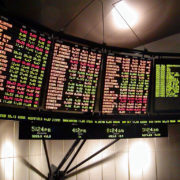LOOK FOR HIGH-YIELDING STOCKS TO COMBAT HIGHER INTEREST RATES
Originally published in  November 10, 2016
November 10, 2016
We’re past the election now, and one thing that hasn’t changed is that it’s starting to look more and more that come December, interest rates in the U.S. will start moving higher.
It’s like crying wolf. For the last few years stock-market experts have been predicting a hike in interest rates. As economic growth has stalled, so has the anticipated rise in rates. Market forecasters are weighing in again and are now predicating interest rates in the U.S. to rise going into year end. Bankrate.com quotes Charles Carlson, CEO of Horizon Investment Services, who says, “Mirroring the consensus among experts in general, most of the mavens say Federal Reserve policymakers are likely to raise interest rates at their December meeting.”
Conventional wisdom says that as interest rates rise, interest- or dividend-paying investments will drop. In fact, after having risen sharply through the summer, dividend-paying stocks have dropped nearly 10% over the last two months. Why should these investments drop? Let’s say that you own a General Electric GE, +2.63% bond that yields 1.5% per year. If rates are at zero, 1.5% is a good deal, and there is demand for that bond. If rates rise and I can get 2% on a government-insured deposit, why would I bother with the GE bond? What then happens is that the price of the bond falls as there is a lack of demand.
Based on that principle it would make sense that dividend-paying stocks would suffer a similar fate. After all, if you get a 3.3% dividend from Coca Cola KO, -3.15% stock, that’s great compared with a zero interest rate on a deposit. But if rates move higher, that 3.3% is much less intriguing and the price of the stock could drop.
Slow and steady
Interestingly, the theory regarding dividend stocks is not at all crystal clear. In fact, if you take a look at some historical figures, you will see that high-yielding dividend-paying stocks may be the way to go.
MSCI produced a research paper that reported, “we examined yield factor returns for the 88-year period ended July 2015. We found that, when rates were low to begin with, high-dividend stocks outperformed the market by an annualized 2.4 percentage points when rates started to go up.”
According to research from Global X, since 1960, there have been 10 cycles of meaningful interest-rate raises. In three of those cycles, dividend stocks underperformed the broader market. In eight of the periods, there was significant overperformance from these stocks. Generally. those numbers are not too persuasive. I wouldn’t generally advise clients based on that kind of data because it isn’t overwhelmingly pointing to potential success. But if you dig a bit deeper into the data, an interesting trend stands out.
According to Global X, “The three instances of underperformance occurred in periods with among the most rapidly increasing interest rates.” This means that in the three periods when dividend stocks underperformed the market, the Federal Reserve raised interest rates aggressively in a short amount of time.
In the seven cycles where high-yielding dividend stocks outperformed, the Federal Reserve raised rates over a prolonged amount of time in a much less aggressive fashion. If you were to poll economists and market analysts as to how they view the pace of the upcoming rate hikes, it will be nearly unanimous that it will be a slow, drawn out process. If that is true and we learn from history, high-yielding dividend stocks may very well be the way to invest.
Good Sign
In general, a dividend strategy has merit. Solid companies with long histories of paying dividends (like Johnson and Johnson), tend to be companies doing well and generating profits and substantial cash flow, and they are returning that money to shareholders.
There is certainly value in dividend paying stock investing if done in a context that helps you meet your goals. It also may be the prudent way to invest when interest finally rise. Speak with your financial advisor to learn how to incorporate high-yielding dividend paying stocks in your portfolio.
The information contained in this article reflects the opinion of the author and not necessarily the opinion of Portfolio Resources Group, Inc. or its affiliates.



